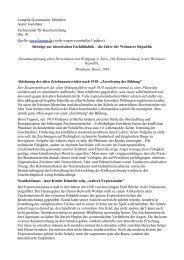Research in Visual Arts Education - The National Society for ...
Research in Visual Arts Education - The National Society for ...
Research in Visual Arts Education - The National Society for ...
Create successful ePaper yourself
Turn your PDF publications into a flip-book with our unique Google optimized e-Paper software.
MEDIATED ACTION AND AESTHETIC LEARNING<br />
the outcome of his study, Lars L<strong>in</strong>dström (2002b) discusses how school can<br />
nurture students’ creativity. A summary of the study and its implications,<br />
published <strong>in</strong> the International Journal of Art & Design <strong>Education</strong> (L<strong>in</strong>dström,<br />
2006), received an <strong>in</strong>ternational research award <strong>in</strong> the name of Brian Allison.<br />
Sociology of aesthetic education<br />
Culture, aesthetics and school are key concepts <strong>in</strong> a project co-ord<strong>in</strong>ated<br />
by Lena Aul<strong>in</strong>-Gråhamn 1999–2003, with the support of Professor Jan<br />
Thavenius. In reports and books, such as Kultur och estetik i skolan [Culture<br />
and Aesthetics <strong>in</strong> School; Aul<strong>in</strong>-Gråhamn & Thavenius, 2003] and Skolan och<br />
den radikala estetiken [School and the Radical Aesthetics; Aul<strong>in</strong>-Gråhamn,<br />
Persson & Thavenius, 2004], the group members develop a sociological theory<br />
of aesthetic experience. <strong>The</strong>y want to show how the way <strong>in</strong> which we th<strong>in</strong>k<br />
about and use the aesthetic is <strong>in</strong>fluenced by its <strong>in</strong>stitutional framework,<br />
such as the school, the art world or the market. For a long time, conceptions<br />
of art as be<strong>in</strong>g decorative and creative expression as be<strong>in</strong>g essentially spontaneous<br />
came to dom<strong>in</strong>ate the way <strong>in</strong> which art education was thought of,<br />
at least <strong>in</strong> the earlier years of education. This conception the group calls<br />
“the modest aesthetics”, s<strong>in</strong>ce its modest claims have probably contributed<br />
to the marg<strong>in</strong>alisation of aesthetic elements and perspectives <strong>in</strong> school.<br />
<strong>The</strong> most <strong>for</strong>ceful power <strong>in</strong> the contemporary aesthetic field is what<br />
Aul<strong>in</strong>-Gråhamn et al. (2003; 2004) call “the market aesthetics”, a corollary of<br />
Paul Duncum’s (2007) designer capitalism, “where the economy is no longer<br />
thought to be based on desire so much as on the drive to cont<strong>in</strong>ually create<br />
evermore desire” (p. 286). It is a possible scenario that the school of tomorrow<br />
will open the gates <strong>for</strong> designer capitalism and its need <strong>for</strong> competence<br />
<strong>in</strong> design, media, visual culture etc. Accommodations like these, however,<br />
will not have large effects. Market aesthetics cannot be balanced by anyth<strong>in</strong>g<br />
less than a trans<strong>for</strong>mation of how the school looks upon its mission. Here<br />
the late-modern Western artist can serve as a role model, the group claims.<br />
Like the art world, the school can become a democratic community with<br />
freedom of speech, both as a human right and as an ability to communicate,<br />
Aul<strong>in</strong>-Gråhamn and Thavenius (2003) imag<strong>in</strong>e. <strong>The</strong>ir vision of the school<br />
as a classic participatory democracy, practis<strong>in</strong>g a democratic way of life,<br />
rem<strong>in</strong>ds us of John Dewey’s ideal, <strong>in</strong>spired by the early North American settlements<br />
and their <strong>in</strong>stitutions (Westbrook, 1991). By per<strong>for</strong>m<strong>in</strong>g <strong>in</strong> the arts,<br />
the student and his or her thoughts become “visible” and “public”, they contend.<br />
But unlike Dewey (1911), who suggested that learn<strong>in</strong>g should imitate<br />
the experimental methods used <strong>in</strong> science, Aul<strong>in</strong>-Gråhamn and co-workers<br />
NORDIC VISUAL ARTS EDUCATION IN TRANSITION 59



